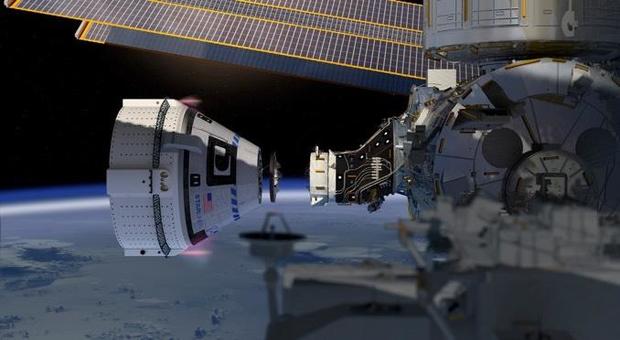Boeing's Starliner capsule cleared for milestone uncrewed test flight to space station
While a handful of open items remain, Boeing managers in a flight readiness review Thursday cleared engineers to proceed with the long-awaited — and oft-delayed — December 20 launch of a Starliner capsule on an unpiloted test flight to the International Space Station.
The holiday-season flight is one of the final hurdles the company faces before astronaut ferry flights can begin next year, helping end NASA's sole reliance on Russian Soyuz spacecraft for basic transportation to low-Earth orbit.
"NASA and Boeing are ready to demonstrate the capabilities of the CST-100 Starliner spacecraft on top of a human-rated Atlas 5 rocket," NASA Deputy Administrator James Morhard told reporters after a flight readiness review concluded. "This is the first flight test to the International Space Station of this crew-capable system.
"I'm happy to announce we're go for launch for Boeing's uncrewed orbital flight test next Friday morning."
The CST-100 Starliner, carrying an instrumented astronaut test dummy known as Rosie, is scheduled for liftoff atop a United Launch Alliance Atlas 5 rocket from pad 41 at the Cape Canaveral Air Force Station at 6:39 a.m. EST next Friday, kicking off a two-day flight to the space station.
After a series of tests to verify its maneuverability and control, the capsule will move in for an autonomous docking at the station's forward port around 8:08 a.m. on December 21, the same port used by the space shuttle and, earlier this year, by a SpaceX Crew Dragon spacecraft during its own unpiloted test flight.
For its initial test flight, the Starliner will deliver a few supplies to the station's six-member crew, along with holiday gifts.
If all goes well, the Starliner will remain attached to the lab complex for a week, undocking around 2:15 a.m. on December 28. Protected by an advanced heat shield, the Starliner will plunge back into the atmosphere and descend to a parachute and airbag-assisted landing at the White Sands Missile Range in New Mexico around 5:48 a.m.
"This uncrewed test flight is not just another contract milestone," said Phil McAlister, director of commercial crew development at NASA. "It's just a phenomenal opportunity for us to learn the true performance of the spacecraft. Computer models are great, but they only go so far.
"Seeing how the spacecraft actually performs in the operational environment of space is a huge confidence building measure," he said. "It's going to provide us with the critical data we need for the final certification."
Since the shuttle program's retirement in 2011, NASA has relied on the Russian Soyuz to carry U.S. and partner astronauts to and from the International Space Station. But in 2014, after a series of design competitions, NASA awarded contracts to Boeing and SpaceX to develop new American spacecraft as commercial ventures.
SpaceX, under a $2.6 billion contract, is building a crewed version of its Dragon spacecraft that will ride into orbit atop the company's Falcon 9 rocket. A Crew Dragon spacecraft completed a successful unpiloted flight to the space station in March. If all goes well with an in-flight abort test, expected in early January, SpaceX will press ahead for its first piloted test flight sometime in the first quarter of 2020.
Boeing is developing the Starliner under a $4.2 billion Commercial Crew Program contract. The Starliner relies on a United Launch Alliance Atlas 5 rocket for the trip to orbit. The company has carried out an on-pad abort test, but the unpiloted flight to the station next week marks the most significant milestone to date in Boeing program.
"We'll get an enormous amount of data throughout the mission, and everything we capture is critical to performing our next crew flight test and achieving NASA certification," said John Mulholland, vice president and manager of Boeing's commercial crew program.
"Our team has partnered with NASA on every domestic human spaceflight program, and we're incredibly proud to continue that legacy."
The Crew Dragon and CST-100 Starliner both will carry supplies and four to five astronauts at a time to the space station. The Starliner will return to Earth with a touchdown in the western United States while the Crew Dragon splashes down in the Atlantic Ocean east of Cape Canaveral.
The first operational crew rotation flights to the station originally were expected in 2017. They have now slipped into 2020 because of funding shortfalls and technical issues, including problems with parachutes and the abort systems needed to propel astronauts away from a malfunctioning booster.
In the most significant setback to date, a SpaceX Crew Dragon was destroyed April 20 during a ground test of its Super Draco abort engines at the Cape Canaveral Air Force Station. Had that test gone well, SpaceX planned to launch the spacecraft atop a Falcon 9 rocket for an in-flight abort test in the early summer timeframe, followed by launch of two astronauts aboard a different crew Dragon in the mid- to late-summer timeframe.
The catastrophic abort test triggered a lengthy delay for SpaceX's program. Boeing, as it turns out, had its own problems, including propellant leaks and parachute trouble. Both companies say those issues have been resolved.






